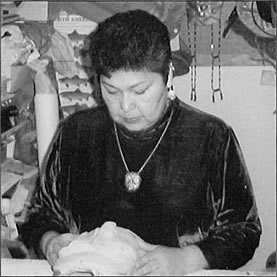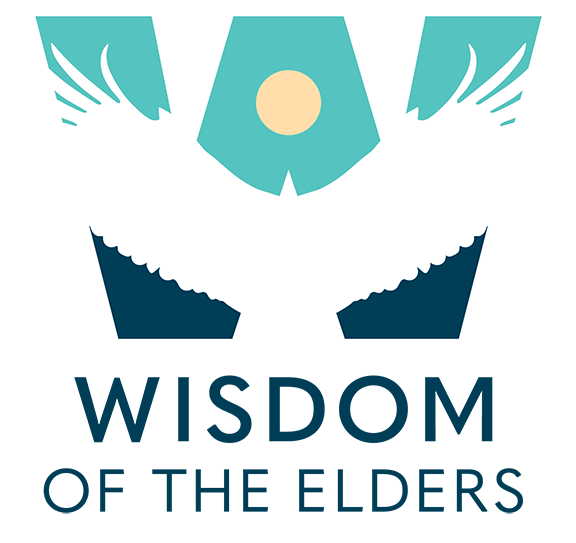It Feeds My Soul

My name is Lillian Pitt and my Indian name is Wakamu and my ancestry on the BIA papers is Warm Springs, Wasco, and Yakama.
The memories of the elders are very special because they are the last of the quote-unquote traditional type of people who saw Celilo when it was a regular fishing place, who spoke only their Indian language, and who dressed the way they dressed.
I fell in love with ceramics and loved the way it felt. I loved the way it smelled. I just dreamt about it. I became obsessed with ceramics, with clay and couldn’t quite realize what I wanted to make. I made some masks. There were different kinds of masks: Alaskan, and African, and Southwestern, and Northwest Coast.
I feel that it is a sacred act, although I am not a spiritual type of person when I am really working with it, it is kind of sacred to me because I’m in a meditative state and I am very calm and very peaceful with it and so I don’t know that there is a… anything was written about it. It is just how I feel. There is just this intimacy and closeness with it and I feel like it is a blessing to do this
Some of them are very abstract and I do series. I do a woman’s series in which I have a spider woman and she is very beautiful. They seem to turn out exquisite without my help. I take them through the one process and as they go through the other process, they get their own spirit. In the raku firing, they get so beautiful. I just love them. Spider-Woman is made to honor the women that hold the families together, teach the children, and have to build and rebuild their homes. I like to name them after my mother, my grandmother, and my sister and all these precious women that I know, and most of them are gone.
There is a Feather woman who has an abstract eagle feather on her head. I can’t use eagle feathers because they are commercial items. I just make clay feathers to honor women who are our teachers. Those pieces I feel very privileged in doing, as well as doing, the Hawk Woman, and the Bird Woman, Coyote Woman, Wolf Woman
There is a stick Indian mask and the stick Indians are legendary beings that live in the mountains and they will whistle a good person to safety if they are lost, and a bad person deeper into the forest. If children misbehave while picking huckleberries or hunt, the stick Indians will steal them from beneath their covers at night, never to be seen ever again. That’s why we really behaved when they were in the mountains. I do stick Indians and my only criteria are giving the pursed lips and that has been somewhat characteristic of my work is having the whistling lips.
Then there is She Who Watches from the pictograph from the Columbia River Gorge. She is on the Washington side but she is overlooking the river and the Oregon people and I have done her in all different methods, even drypoint prints.
She overlooked the village where my great-grandmother lived and so there is that personal connection with her. She did a good job because if it weren’t for my great-grandmother, I wouldn’t be here. I didn’t know about her until the elders told me about her. That’s where my great-grandmother lived until 1910 and got moved to Washington. I later found out the bones that were from Memaloose and the Wishram cemetery, when they were returned, my great grandmother was one of those people. I didn’t know that until last year. The reburial of my great-grandmother’s bones back to the earth makes the image ten times more special. All these images are very personal to me and very loved. Every time I do them, it is just like a prayer of thanksgiving for my people for the river people, for the salmon, for the deer and you know, it feeds my soul.
Lillian Pitt
Lillian Pitt, Yakama, Wasco, and Warm Springs artist from the Columbia River Gorge is known as a great innovator within her tradition and is deeply influenced by the rich culture of Columbia River tribes of the Northwest. She has chosen to work in clay using Asian techniques like raku and anagama, to work in bronze or precious metals, to incorporate wood, copper, glass, shell, leather, feathers, and a wide variety of materials, and to mix media and technologies from around the globe.
Lillian Pitt began working with clay as a medium at the age of thirty-five. At this early stage, for inspiration, she looked in books and copied various indigenous mask forms in clay. With the encouragement of R.C. Gorman as well as the support of Vance Perry, Christy Runyan, and Pat Horsley, Pitt learned about clay bodies and the techniques of hand building, glazing, and raku firing. As Lillian worked with indigenous images, she also began to search for a way to present her own tribal experiences and began to make masks representing Spilyay (Coyote), Stick Indians, and other characters in the stories she grew up with at Warm Springs. Lillian used materials such as buckskin, feathers, shells, bones, glass beads, and clay to represent the natural world and the life forces around us. With the exception of clay, all materials are traditionally used by her people to beautify and enhance their environment. In Lillian Pitt’s Indian ways and thought there is no word for art, only the making of good objects. Her artwork is a testimony to the greatness of her people and to her own quiet persistence as an artist committed to making clay speak. The work of Lillian Pitt whispers to us with the wisdom of her ancestors and tells us that the magic and miracles needed to make the future possible reside in ancient stories handed down for generations on both sides of the Columbia River Gorge.
At the turn of the millennium, Lillian’s art took on an even larger dimension. She and a team of Native American artists were commissioned by the city of Portland, OR, the Oregon Convention Center, Portland State University, and a variety of other municipalities and cultural institutions to create public art that reflects this heritage. Art and cultural councils, tribal centers, tribal casinos, historical museums, various community associations, restaurants, and theaters have also commissioned Lillian. Lillian Pitt’s art has been featured across the United States, Canada, Japan, Korea, Germany, Siberia, the Czech Republic, and New Zealand.
In 1990 Lillian received the Oregon Governor’s Award for the Arts. In 2000 she received the following awards: First People’s Fund, Community Spirit Award, Rapid City, South Dakota; Indian Art Northwest, 1st place, Ceramics, Portland, Oregon; Indian Art Northwest, 2nd place, Jewelry, Portland, Oregon. She requires six weeks’ advance notice to fulfill speaking engagements.
Learn more about Lillian Pitt at lillianpitt.com
503-252-1854
lillianpitt@hevanet.com
